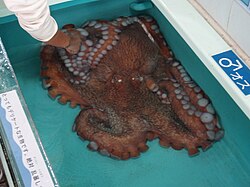Octopoda
Octopoda is one of the largest orders which contain the common octopus and some other types.[1][2] Fossils are rare, but they do have a fossil record starting in the later Carboniferous.
| Octopoda Temporal range: 323 mya Upper Carboniferous – present
| |
|---|---|

| |
| The common octopus, Octopus vulgaris. | |
| Scientific classification | |
| Kingdom: | |
| Phylum: | |
| Class: | |
| Subclass: | |
| Superorder: | |
| Order: | Octopoda
|
| Suborders | |
Octopods are put into two suborders. One, the Incirrina, is composed of the well-known Octopus of rocky shores and coral reefs and its relatives. The other suborder, the Cirrina, contains octopods whose tentacles are linked by an umbrella-like mantle, so their activity is rather different from the common octopus.
Octopoda Media
A giant Pacific octopus at Echizen Matsushima Aquarium, Japan
Diagram of octopus from side, with gills, funnel, eye, ocellus (eyespot), web, arms, suckers, hectocotylus and ligula labelled.
A finned Grimpoteuthis species with its atypical octopus body plan
A common octopus (Octopus vulgaris) moving around. Its nervous system allows the arms to move with some autonomy.
Adult male Tremoctopus violaceus with hectocotylus
Octopus paralarva, a planktonic hatchling
Video of Octopus cyanea moving and changing its colour, shape, and texture
References
- ↑ William Elford Leach, 1818. "ITIS Report: Octopoda Leach, 1818". Itis.gov. 2013-04-10. Retrieved 2014-02-04.
- ↑ Helsinki.fi, Mikko's Phylogeny Archive: Coleoidea – Recent cephalopods









